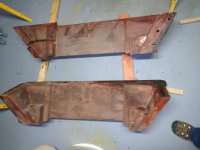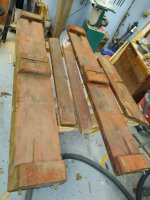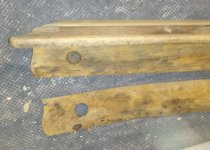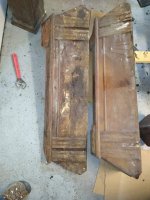I'm not sure where you got the idea that rails are not solid wood, they are definitely solid 3/4" oak. My concern is that the Brunswick catalog for the Algeria and Narragansett from the early 1990's said the the rails are veneered with rosewood and mine are solid oak. I copied the statement below, it appears in the descriptions for both the Algeria and Narragansett tables.
| The cushion rails are of extra heavy construction and firmly bolted to the slate bed. The cushion rail tops are veneered with rosewood, which does not change color, cannot be easily disfigured and does not have the objectionable features of a polished surface. |
So according to the old Brunswick catalogs that they have on the web, my rails should be veneered with rosewood. I can't find any documentation that says they used oak rails on those two table. That combined with the fact that the label was obviously not the original and I found those odd old leg pieces inside the existing legs that I don't believe this is a Brunswick table, it just looks like one.
As for the rest of the table I'm not exactly sure what type of wood it is (poplar??), but its solid and ranges in thickness from 1-3/4 to 2" thick. So far none of it has warped and that still amazes me!
It would just be impossible to reattach the old veneer. As it dried it curled, lifted and cracked. I've done veneer work before and I am aware that to keep things from warping you should veneer both sides. Having said that, I've never veneered anything so thick. A friend of mine restored an old pool hall table from the 1930s and he re-veneered his table. If I decide to do this I'll seek his advice.
I'm planning to reach out to Derrick at Billiard Restoration to get his opinion.




